It’s Tea Time at HKIA
I first visited Hong Kong in the 1970s (in the days before the MTR had been built, when there was no under-the-harbour tunnel, and when one flew into Kai Tak airport) and fell in love with the place. I also visited Macao and thought it tacky in the extreme.
How times have changed!
Nowadays it’s HK which is in desperate need of a spruce up, while Macao – with its amazing casinos – has transformed itself into a tourism destination ‘par excellence’.
But there are pockets of HK that are still nice to visit and which draw in the tourists like there was no tomorrow. One such place is Flagstaff House, built in 1846, that is the oldest example of Western-style architecture remaining in Hong Kong. It is situated in the corner of Hong Kong Park, and is a white Colonial-style building, which was the residence of British commanders until 1984. It has since been turned into a museum which displays everything you could possibly want to know about tea, from cups and porcelain teapots to vintage teaspoons and special ceramics.
Another such place is HK’s international airport on Chek Lap Kok Island, which in my view is one of the best airports in Asia… and has been consistently since it was first opened to the public in the 1990s. (The airport, by the way, is the world's busiest cargo gateway and one of the world's busiest passenger airports. Terminal 1's title as the world's largest was surrendered to Beijing’s T3 on 29 February 2008.)
Helpfully, travel website rome2rio.com tells us that “There are 6 ways to get from Hong Kong Airport to the Flagstaff House Museum of Tea Ware by subway, bus, taxi, car or towncar”.

Likewise the thaiairways.com site informs us that “If you like tea, we recommend the Flagstaff House Museum of Tea Ware, on the corner of Hong Kong Park.”
What both signally fail to have noticed is that you don’t actually need to take one of the "six" means of transport from the airport to Flagstaff House. Instead, if you go to the Departure Hall of Terminal 1, head up to the 6th level and look for Gate 36, you will find that Flagstaff has come to you.
Or rather, one of HK Airport’s famed temporary exhibitions has been set up here. It’s called, appropriately enough “From Clay to Teapot: Tea Ware by Hong Kong Potters 1986-2016”.
Between 1986 and 2016 the Flagstaff Museum has hosted 10 competitions and exhibitions, with the aim of encouraging the active participation of ceramic art enthusiasts to inject modern elements and vitality into tea ware by displaying practical and original ceramic tea vessels, so as to promote public interest in ceramic art and tea culture… (well, that’s what the blurb says at any rate).
The Flagstaff House Museum of Tea Ware is actually a branch museum of the Hong Kong Museum of Art. Being able to sniff out a good PR opportunity is what this little exhibition of tea pots is probably all about – though to have the exhibition housed in the departures area rather than in arrivals (or even better landside) must have been a disappointment for the museum’s PR gurus.
It doesn’t take more than about 10 minutes to check out all the glass cabinets. Like all artwork, which is highly subjective at the best of times, it’s what we Brits refer to as a “curate’s egg” collection – ie good in parts.
Here, is a teapot in the shape of a Bamboo Shoot (by Lee Wo Ling, made in 1992) and beside it a teapot in the shape of a bundle of bamboo (by Lau Yuk King, dated 1996). I can’t say I’d really want either in my home, though no doubt the artists have done a fine job. It’s just that I don’t actually like them very much!
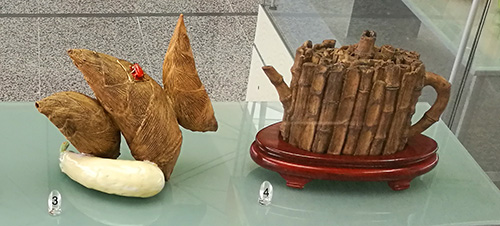
This next one, however, really catches my eye. It's called ‘Round and Bond’ and was made by Leung Anna in 2006. Would I want to drink tea out of it? Hmmm… Maybe not. But it would certainly look good as a display, albeit that I might well tire of dusting it!
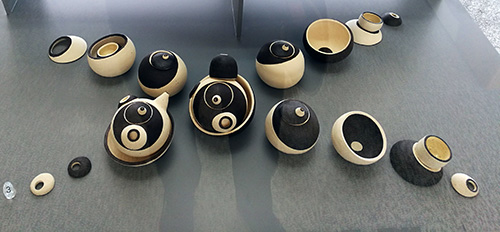
This next one (Yuanyang 2, by Tsang Cheung Shing in 2002) is another for my reject pile. I’m afraid I don’t like the cups, and having two faces doing a deep throat with one another, purely so you have somewhere to hang the cups seems like Mr Tsang is over-egging the pudding somewhat.
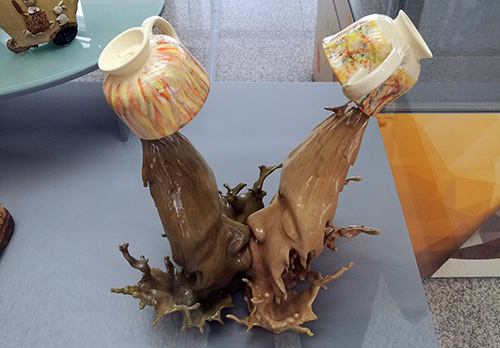
This next is called ‘Tea Set of Goat Shape’ and was made in 1992 by Tam Cheung On. Again, quite a clever idea, but not my cup-of-tea, frankly.
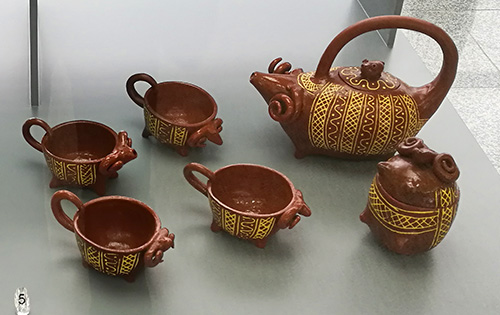
Likewise ‘Lotus Root, Support Under the Soil’ by Wong Mei Han (2013) is not really my taste at all. You can imagine the artist’s parents getting these as gifts for Christmas, or whenever, and wondering what the hell they can do with them so as not to upset their prodigy! (Answer: place them in a cardboard box and hope the artist becomes famous one day, so you can donate them to a museum!)
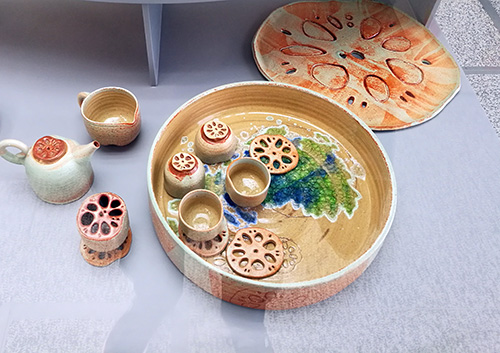
This is a little better, don't you think? 'Rhythm of Clear Stream Flowing Amid Stones' by Wong Tsz Shan in 2013. But I can’t really see it being of practical use. And how many times would you successfully do the washing up without breaking one of the little blighters?
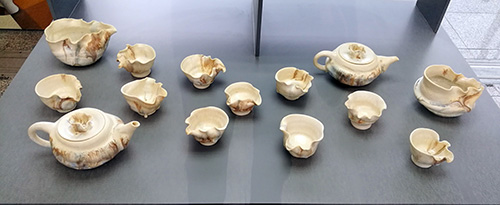
'Yuanyang Cups and Saucers', made by Fung Siu Han in 2002, is quite a fun idea. But if I were given a set I’d probably end up using them for a strong black coffee on the morning-after-the-night-before.
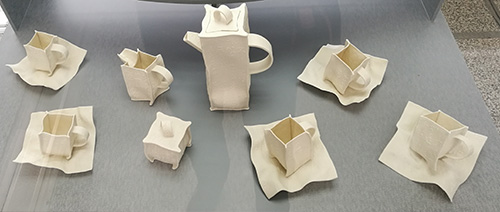
‘Reminiscence’ (Lee Ngo Cheung, 2013) and ‘Nature and Magic’ (Li Si Kwan, 2002) are quite fun, but again I think these would be decorative pieces rather than actually being put to any practical use.
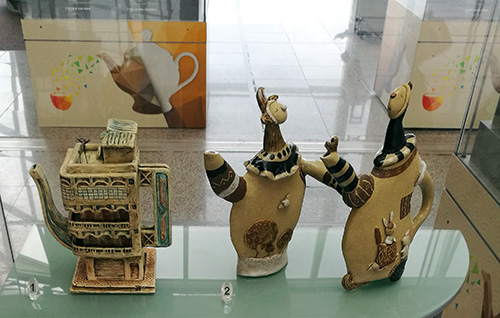
And this fish pot by Kwok Hoi Yee (1986) would probably be far better off containing fish gravy (what the Vietnamese call nước mắm and the Thais call Nam Pla - น้ำปลา) rather than tea.
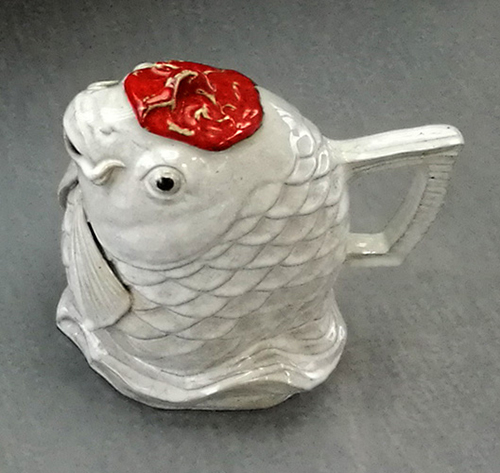
Lastly, ‘Liquid Collection: Drinking tea with Morning Dew’ by Law Hon Wah (2013) also caught my eye. Maybe it’s because the day I passed through the airport was Valentines (see what a romantic your favourite blogger is!). I doubt I’d drink my tea out of it, though.
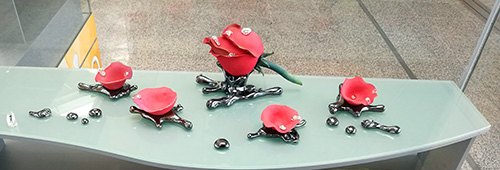
The point that everyone has missed, however – including the museum itself – is that scientific experiments carried out by food psychologists (yes, they really do exist!) have shown beyond doubt that tea drunk out of a mug coloured red is perceived to taste a whole lot better than mugs of other colours. And also that tea “tastes” better out of thin porcelain, whilst coffee “tastes” better out of a thicker mug. (There was a BBC documentary on this very subject just a few weeks back, so it must be true, LOL.)
So for the time being, at least, this particular art-philistine will continue to drink his tea out of his nice red-patterned Chinese mug in order to enjoy it to the max.
But well done to the managers of HK Airport for encouraging the local artists in this way. Love the exhibits or hate them, it’s a good way of making the travelling experience more enjoyable.
